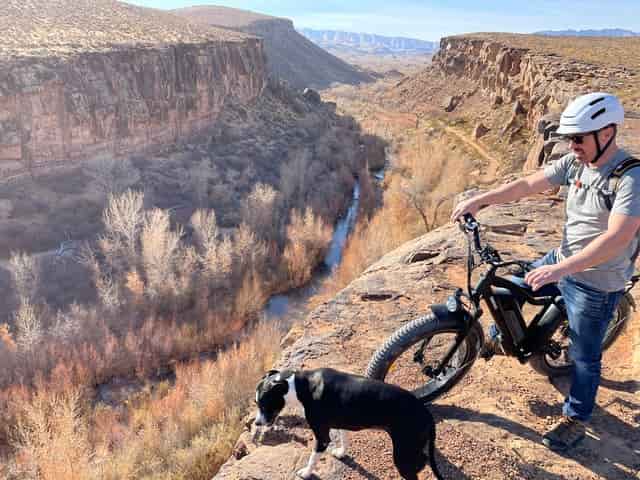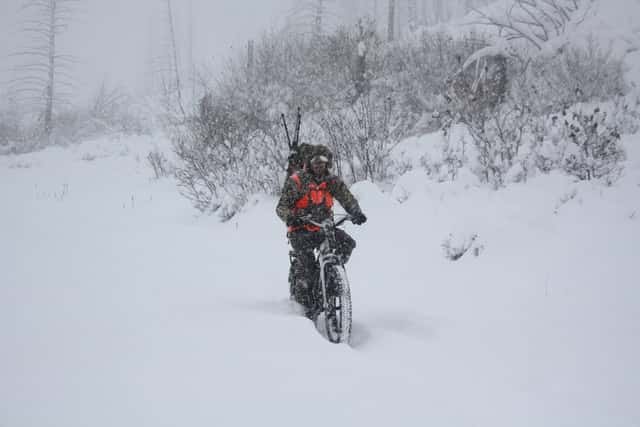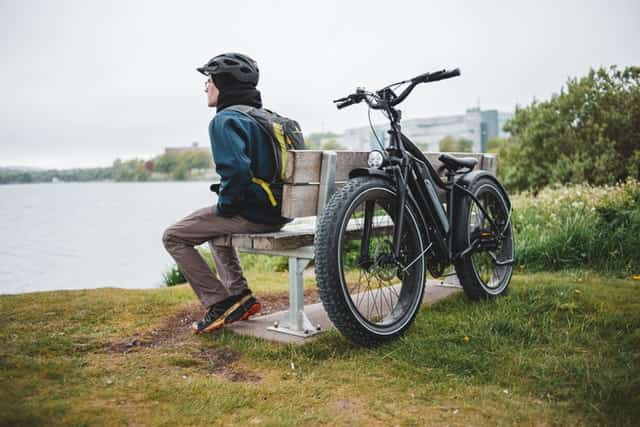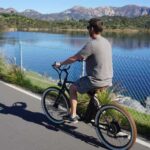Getting into cycling as a hobby can seem daunting. There are so many different types of bikes, all seemingly built for one purpose, one type of terrain or riding style. Then there are fat tire bikes, with their almost comically oversized wheels, claiming to have amazing versatility and to be newbie friendly.
Is there any truth to these claims? It may be hard to believe, but the answer is yes. Fat tire bikes are good for beginners, particularly when practicing riding off road.
These bikes are as versatile as advertised, able to take on essentially any terrain while offering some of the most forgiving handling available.
If this sounds too good to be true, just keep on reading. I’ll give you the rundown on what makes fat tire bikes stand apart from the competition, and why you should seriously consider one for your first ride.
What Are Fat Tire Bikes and How Are They Different?
It Starts With the Tires
Let’s start with the defining feature of a fat tire bike: the tires. Fat tires are so named thanks to their greater than average width. At their narrowest, they are 3.7 in wide. The fattest are a whopping 5 in in width.
Contrast that with your average mountain or trail bike tires, which measure between 2.25-2.5 in, and you see why fat tire bikes are in their own category.
Larger tires gain a few properties over more slender variants.
The primary change is increased contact with the terrain. They also have greater surface area, meaning more rubber on the trail, which provides more efficient weight distribution and makes it easier to maintain balance.
Of course, that additional rubber comes with a few extra pounds. The average fat bike tire is around 3.5 lbs, with tubes ranging between 1.5-2 lbs. Taken together, that could be as much as 10 lbs in tire weight alone.
This can be a positive, considering the weight improves stability and sturdiness, both important traits on the terrain these bikes are built for.
Big Wheels
To accommodate the larger wheels, fat tire bikes have made a few changes to their wheelsets.
The materials used are the familiar aluminum alloy and carbon fiber, though with rims as wide as 100 mm, they can dwarf normal bike wheels.
To help reduce the weight of these big wheels, many fat tire bikes with aluminum rims will feature cut outs. While such a measure can save some weight, it prevents those rims from being used with tubeless tires.
As going tubeless eliminates the pinch flats that can occur at the low tire pressures common for fat tires, the small weight advantage from cutouts may not be worth it.
Carbon fiber rims can reach those lower weights without the need for cutouts, making them the ideal alternative if you absolutely want your bike to tip the scales as little as possible.
Regardless of the material they are made of, fat tire wheelsets feature thru axles as opposed to the quick release axles you may be used to.

Native Suspension
Most fat tire bikes, particularly at low and mid range prices, feature “rigid” suspension, which is another way of saying they have no suspension. This is more common for road bikes intended for use on smooth terrain, so it may seem counterintuitive for an all-terrain fattie.
However, just because the frame lacks a suspension system doesn’t mean there is nothing to keep you from feeling every rock and root you roll over.
The fat tires actually provide a fair amount of cushioning and shock absorption, particularly at lower pressures.
Relying on this type of native suspension is fine on moderately variable trails, and it is better than any alternative when riding on sand or snow. On truly gnarly ground however, conventional suspension is superior.
Luckily, the two systems are not mutually exclusive. You can pair fat tires with a suspension fork to get the best of both worlds. The best choice is a lockable suspension, so you can choose which type best suits each individual ride.
Frame Geometry
As with any type of bike, not every fat tire bike frame is the same. They are built with the primary function of being able to traverse a wide variety of off-road terrain, but they can be specialized more towards incline riding, trail riding, or even racing. Yet there are a few identifying frame elements they will share.
Fatties tend to have a head tube with a steep angle, because this improves handling on uneven ground. A longer chainstay length contributes to their overall stability, while a shorter wheelbase helps with maneuvering.
The most distinctive frame element of fat tire bikes is their wide bottom brackets. They are the widest you’ll find on any bike, all to accommodate those beefy wheels.
This also means these bikes have a greater stance width than other bikes, which can be troublesome when riding among obstacles.
If you plan to ride narrow trails where your pedals could clip or snag on brush or debris, you should aim for the narrower end of the fat tire range.
Recommended Fat Tire Bike: Mongoose Juneau 26-Inch Fat Tire Bikes ( Amazon Link )
5 Reasons To Buy Fat Bikes

1 ) Ultimate Terrain Versatility
There are many specialized bikes out there, fine tuned to handle just one type of thing well. Gravel bikes can adroitly cover loose and rocky ground. Trail bikes can handle bumpy dirt roads and inclines, while MTBs can withstand the shocks of truly technical riding.
Fat tire bikes can do all of these things, just as well or better than some of their more limited competition. The extra surface area provided by those wide tires provides stability on the rockiest roads.
They are just as knobby as MTB tires, so they can get a good grip on packed dirt, gravel, or even sand.
In fact, their ability to travel over the loosest terrain is what really sets them apart from the pack. You can ride a fattie right off the boardwalk and onto the sand of the beach without sinking in and being mired.
Live in a snowy area? Just lower the tire pressure, and take your FTB out for a brisk ride over the snow.
You can ride at pressures as low as 5 PSI, allowing those tires to spread out nice and wide and distribute your weight over unstable surfaces. This adaptability doesn’t fail if the weather turns bad, either.
Fat tire bikes can be ridden in wet, muddy conditions, too. It only takes simple tweaks to adjust these bikes to fit their circumstances.
Low tire pressure is better for general off road riding, while the lowest is best suited for sand and snow. You can ride on flat surfaces like asphalt and pavement too, though a firmer pressure would benefit you in such cases.
Related Post: Best Fat Tire Bikes For Women 2021 | Review & Comparison
2 ) Increased Comfort
While a fat tire may not be able to completely replace traditional suspension systems at the extremities of riding, they do a perfectly good job in the mid range.
Cyclists often refer to riding fatties as “cheating,” as, in many situations, they can transform a ride over difficult terrain from something jarring to something fun.
Is there some jarring rocky scree that you always avoid? Or maybe a part of your favorite trail becomes muddy after a storm and getting through it is a slow, exhausting slog. On a fat tire bike these obstacles become afterthoughts.
Those puffy tires smooth out all the bumps in the road. Suspension forks are often too stiff to respond to small impacts, but fat tires cushion everything. Moreover, their greater weight gives them a more solid, grounded feel.
Your overall riding experience or ride feel in short isn’t the only element of cycling comfort, though. You need a bike that can comfortably hold you and your gear.
Fat tire bikes naturally have a higher carrying capacity than other bikes, usually around 300 lbs. That not only means they can bear a heavier rider, but that their performance won’t suffer from the weight of your cargo.
What could be more comfortable than knowing your bike can carry you anywhere you want to go, with whatever you need to bring?

3 ) Improved Off Road Handling
We’ve discussed how versatile these bikes can be, and it’s true that they can be ridden in practically any environment, under a variety of conditions. But, the fact is they are designed to excel at off road riding, and that is really their biggest selling point.
Other MTBs can take on difficult terrain, and bikes like hybrids can adapt to a variety of terrains. But, the fattie manages to outshine many of these competitors by providing better handling in the same conditions.
As is often the case with these bikes, the tires have a lot to do with this. The wide contact points of the fat tires make it noticeably easier to achieve and maintain balance, even at lower speeds.
All that contact area also allows the tires to gain greater traction, so you feel you are gripping the road, even when the “road” is actually a snow bank or mud slick.
Instead of sliding to the outside when cornering, a fat tire bike goes where you direct it. This also increases braking effectiveness, as the tires, combined with the bike’s increased weight, can really dig in to reduce speed quickly.
This could make the difference between a ride ending collision and a fun, exhilarating experience.
4 ) Less Maintenance
Routine maintenance is part of owning a bike. You’ll need to wipe your bike down between rides, keep the chain and joints lubricated, and see to the occasional flat no matter what kind of bike you choose.
Yet, beyond this everyday upkeep, fat tire bikes tend to require less maintenance and repair than other bikes.
The problem of flats can be dramatically reduced by going for tubeless tires. This is true of any bike, but is especially useful for fat tire bikes and MTBs. When tires hit the ground hard enough, they can compress to the point that the inner tube is pinched against the rim.
If the tube ruptures, then you have what is called a pinch flat. It’s more likely to occur when the PSI is lower, which is common for a fattie. But, with tubeless tires, the issue is eliminated.
While I have made a point of highlighting the fact that a fattie can be fitted with a suspension fork, the fact is most of them are not. More to the point, fattie enthusiasts often highlight the lack of suspension as a positive.
The addition of any component to a bike also adds on a corresponding amount of upkeep.
Suspension systems can malfunction, or require the sort of adjustments beyond a beginner’s skill set. Taking them out of the equation simplifies things.
The greater weight and more stolid build of an FTB also helps you avoid trips to the mechanic.
Off road riding is punishing to any bike. The constant vibration and jarring impacts take a toll, and are more likely to cause part failure on a less substantial bike.
The fattie’s big wheels and hefty frame can withstand these conditions better, and for longer.

5 ) A Safer Ride
Last, but far from least when it comes to new riders, is the safety factor. Riding a bike off road increases the risk of accidents happening.
Riding through brush, over unpredictable elevations and unstable ground are all inherently dangerous, though fat tire bikes do reduce the danger.
Their ability to ride over loose terrain is a boon. Many riders fall or falter when a trail transitions from solid dirt to shifting sand, gravel or mud. Fatties are made to maintain stability over all of these terrain types.
You can safely ride from one to the next without worrying that your bike will suddenly lose purchase and become uncontrollable.
The higher weight capacity of a fat tire bike also contributes to your safety. When your bike endures an impact at high speeds, the weight it is carrying is multiplied in that moment depending on just how severe the impact was.
This means that a bike rated to carry 150 lbs can fail if an abrupt collision increases your weight beyond that point. FTBs are much more hearty in this regard, and is more likely to safely bear you even when the going gets rough.
Final Words
A fat tire bike won’t be the right fit for everyone. Even with all of their versatility and performance advantages, they aren’t the best bike for every job. Their increased weight makes them too heavy for serious racing, and their wide bottom bracket can be uncomfortable for some riders.
Yet, it’s hard to argue against a fat tire bike when it comes to off road cycling for beginners. Fatties can go places that other bikes can’t, and maintain a comfortable ride quality along the way.
They are easier to control, simpler to maintain, and safer to ride — exactly the kind of bike to make it easy for new riders to safely learn the ropes.
Also Read,
Can You Mountain Bike without Suspension? – Rigid Mountain Bike
Are Raleigh Bikes Considered Good Quality? 5 Reasons To Buy One
Best Time To Buy Mountain Bikes For Great Deals & Heavy Discount









Leave a Reply